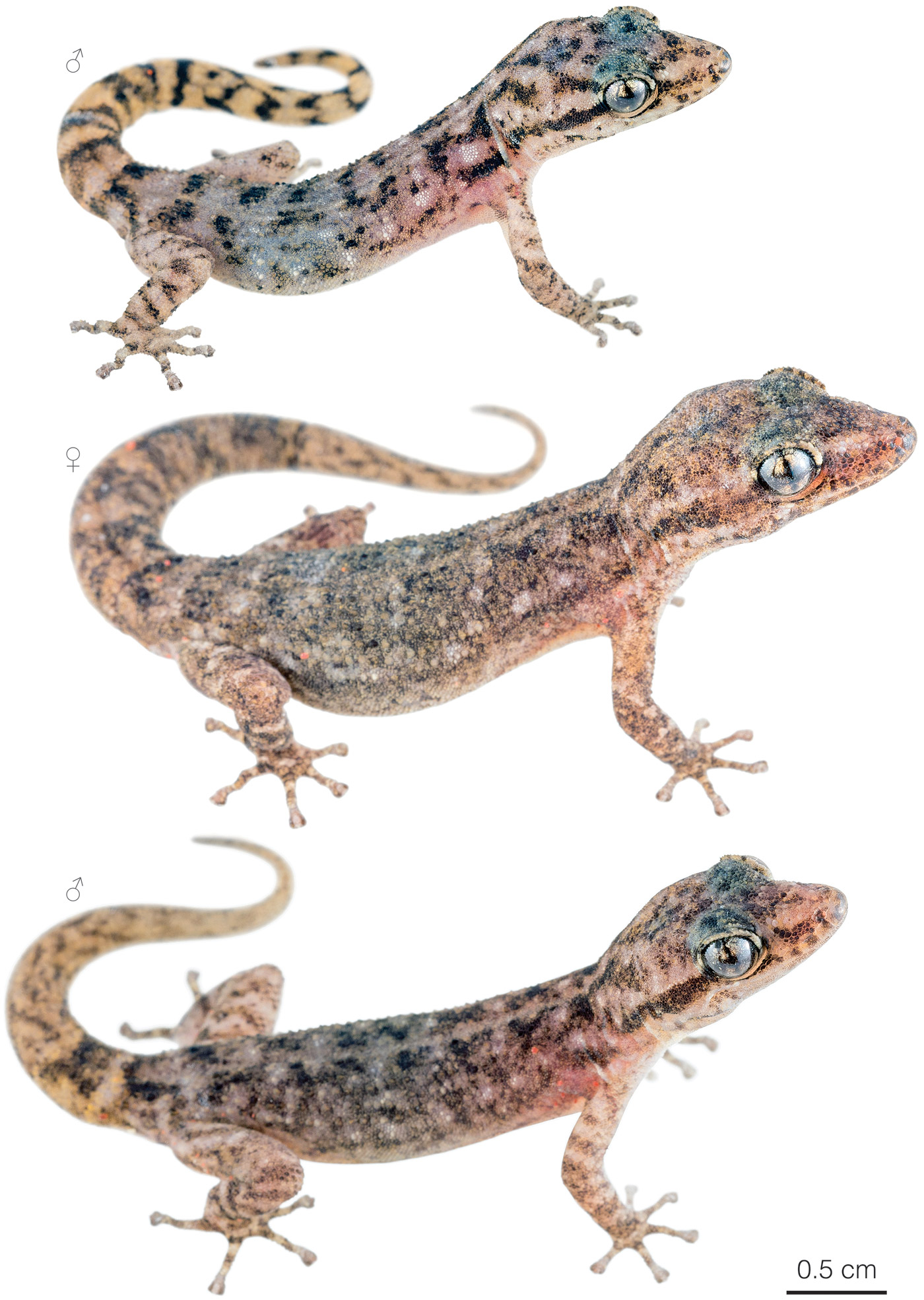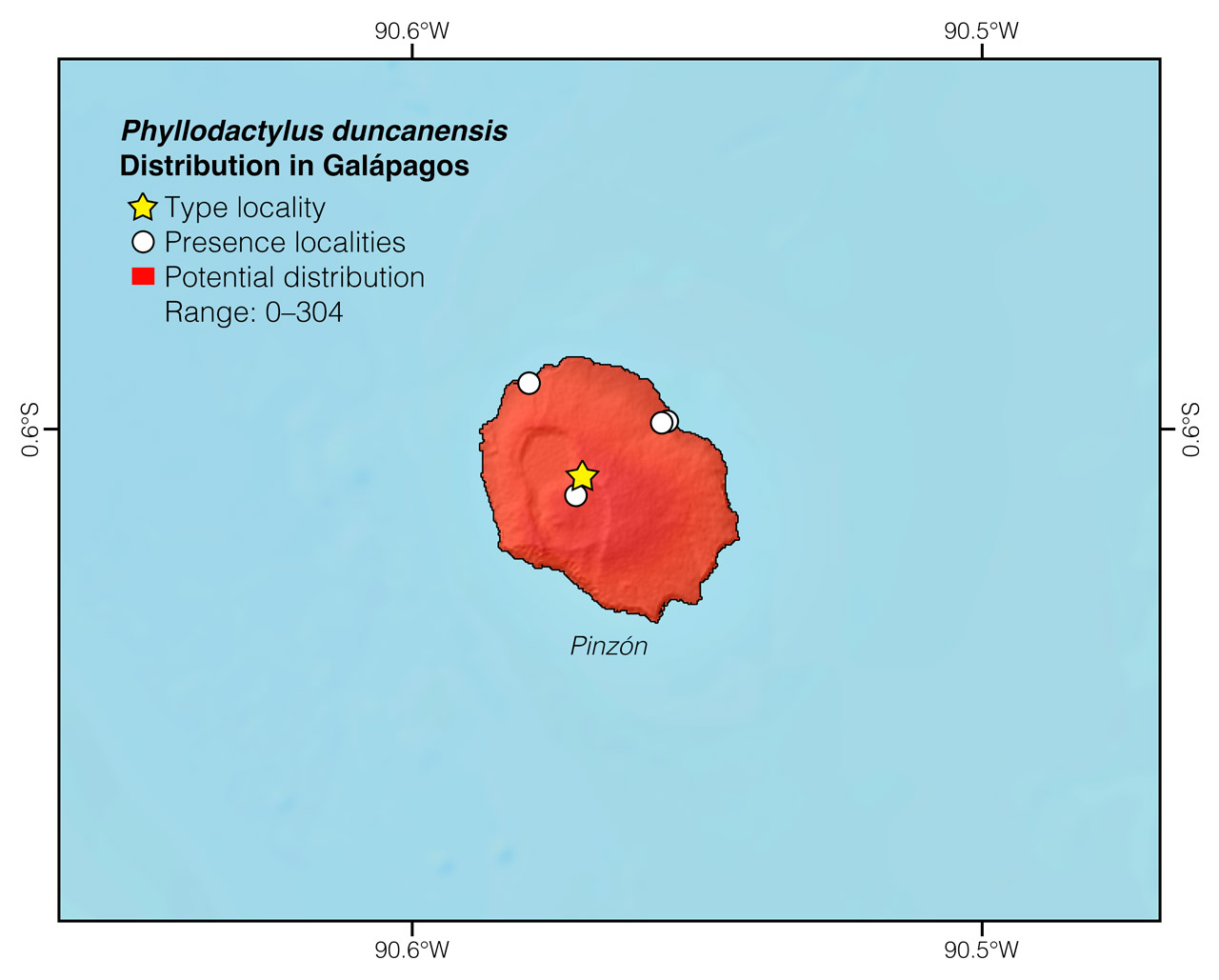Published October 10, 2019. Updated December 22, 2023. Open access. Peer-reviewed. | Purchase book ❯ |
Pinzón Leaf-toed Gecko (Phyllodactylus duncanensis)
Reptiles of Ecuador | Sauria | Phyllodactylidae | Phyllodactylus duncanensis
English common names: Pinzón Leaf-toed Gecko, Duncan Leaf-toed Gecko.
Spanish common names: Geco de Pinzón, salamanquesa de Pinzón.
Recognition: ♂♂ 7.6 cmMaximum distance from the snout to the tip of the tail. ♀♀ 9.5 cmMaximum distance from the snout to the tip of the tail..1 Phyllodactylus duncanensis is easily distinguishable from other native saurians occurring on Pinzón Island (that is, iguanas and lava lizards) by its nocturnal habits, vertical pupils, and fingertips lacking visible claws.1 No other gecko has been recorded on Pinzón Island. The dorsal coloration is usually pale grayish brown with faint irregular dark blotches and scattered white spots (Fig. 1).1

Figure 1: Individuals of Phyllodactylus duncanensis from Playa Escondida, Pinzón Island, Galápagos.
Natural history: Phyllodactylus duncanensis is a nocturnal and crepuscular gecko that occurs in higher densities along the coastline than in the highlands of Pinzón Island. Pinzón Leaf-toed Geckos are primarily terrestrial, moving on soil and rocky outcrops in areas of dry shrubland and dry grassland.1 During the daytime, these geckos seek refuge under lava blocks or in crevices. These microhabitats are also their preferred hiding places in the presence of a threat.1 There are recorded instances of predation on members of this species, including by owls and by snakes (Pseudalsophis slevini).1 There is no information on the reproduction or dietary preferences of this species.
Conservation: Vulnerable Considered to be facing a high risk of extinction in the mid-term future..1 Phyllodactylus duncanensis is listed in this category because the species is restricted to an island of only 18 km2 and, therefore, could be seriously affected by random unpredictable events (like droughts and introduced species) within a short time period. Pinzón Leaf-toed Geckos also faced predation by black rats for nearly 200 years.2 Black rats were eradicated from Pinzón in 2012 and now it is presumed that P. duncanensis does not face major immediate threats of extinction. Pinzón Island is fully protected by the Galápagos National Park.
Distribution: Phyllodactylus duncanensis is endemic to Pinzón Island in Galápagos, Ecuador. Pinzón is a small 18 km2 island with a maximum elevation of 458 m. The island is dominated by spiny shrubs and small trees, but lacks the two most prominent trees in Galápagos: the palo santo tree (Bursera graveolens) and the giant daisy tree (Scalesia).

Figure 2: Distribution of Phyllodactylus duncanensis in Galápagos. See Appendix 1 for a complete list of the presence localities included in the map.

Figure 3: Distribution of Phyllodactylus duncanensis in Pinzón Island. The star corresponds to the type locality: Las Cuevas. See Appendix 1 for a complete list of the presence localities included in the map.
Etymology: The generic name Phyllodactylus comes from the Greek words phyllon (=leaf) and daktylos (=finger),3 and refers to the leaf-shaped fingers characteristic of this group of geckos. The specific epithet duncanensis refers to the type locality, Pinzón, previously known as Duncan Island.4 The island was originally named after Adam Duncan, a British admiral famous for defeating a Dutch fleet in 1797 during the French Revolutionary Wars, an action considered one of the most significant victories in naval history.5
See it in the wild: Pinzón Island is inaccessible to tourism. Researchers and members of the Galápagos National Park may visit the habitat of Phyllodactylus duncanensis, but only in the context of a scientific expedition or a conservation agenda.
Authors: Alejandro ArteagaaAffiliation: Fundación Khamai, Reserva Arlequín, Ecoruta Paseo del Quinde km 56, Santa Rosa de Mindo, Pichincha 171202, Ecuador. and Juan M GuayasaminbAffiliation: Universidad San Francisco de Quito, Quito, Ecuador.
Academic reviewer: Cruz MárquezcAffiliation: University of Rome Tor Vergata, Rome, Italy.
Photographer: Jose VieiradAffiliation: Tropical Herping (TH), Quito, Ecuador.,eAffiliation: ExSitu, Quito, Ecuador.
How to cite? Arteaga A, Guayasamin JM (2023) Pinzón Leaf-toed Gecko (Phyllodactylus duncanensis). In: Arteaga A, Bustamante L, Vieira J (Eds) Reptiles of Ecuador: Life in the middle of the world. Available from: www.reptilesofecuador.com. DOI: 10.47051/SNSQ6007
Literature cited:
- Arteaga A, Bustamante L, Vieira J, Tapia W, Guayasamin JM (2019) Reptiles of the Galápagos: life on the Enchanted Islands. Tropical Herping, Quito, 208 pp. DOI: 10.47051/AQJU7348
- Clark DA (1981) Foraging patterns of black rats across a desert-montane forest gradient in the Galápagos Islands. Biotropica 13: 182–194. DOI: 10.2307/2388123
- Brown RW (1956) Composition of scientific words. Smithsonian Books, Washington, 882 pp.
- Van Denburgh J (1912) Expedition of the California Academy of Sciences to the Galápagos Islands, 1905-1906. VI. The geckos of the Galápagos Archipelago. Proceedings of the California Academy of Sciences 1: 405–430.
- Laughton JK (1888) Duncan, Adam. In: Leslie S (Ed) Dictionary of national biography. Smith, Elder, and Co., London, 159–161.
Appendix 1: Locality data used to create the distribution map of Phyllodactylus duncanensis in Ecuador (Fig. 2). Go to the section on symbols and abbreviations for a list of acronyms used. Asterisk (*) indicates type locality.
| Country | Province | Locality | Source |
| Ecuador | Galápagos | Playa Escondida | Arteaga et al. 2019 |
| Ecuador | Galápagos | Islote Pinzón | Arteaga et al. 2019 |
| Ecuador | Galápagos | Thorn scrub | Clarck 1981 |
| Ecuador | Galápagos | Valley near the top* | Van Denburgh 1912 |